Information »Lunes«
María Bonete Escoto: »Lunes« in: »Estío. Once relatos de ficción climática« (Episkaia, 2018) Information in English & German Translated by Anna Galt
María Bonete Escoto: »Lunes«
in: »Estío. Once relatos de ficción climática« (Episkaia, 2018)
Information in English & German
Translated by Anna Galt
Create successful ePaper yourself
Turn your PDF publications into a flip-book with our unique Google optimized e-Paper software.
María Bonete Escoto: »Monday«<br />
<strong>Information</strong> (English & German)<br />
María Bonete Escoto, born in Elche, Spain, in 1993, is a writer<br />
who lives in Madrid. She studied Modern Languages at Complutense<br />
University in Madrid and has a master degree in Literary<br />
Studies from Vrije University in Amsterdam. She participated in<br />
the climate fiction anthology Estío. Once relatos de ficción climática,<br />
published by Episkaia in 2018. In 2019 the same publishing<br />
house published her first solo work, the short novel No<br />
hay tierra donde enterrarme, a ghost tale which mixes classic<br />
gothic fiction with climate fiction. Since 2017 she has been contributing<br />
articles on videogames and literature to Spanish specialised<br />
media such as Anait Games and Nivel Oculto, and in<br />
2020 she participated in the sixth issue of the zine Heterotopias.
»Monday« by María Bonete Escoto is a climate short story disguised as a thriller<br />
and ghost story, an eerie version of the world that combines the literary tools<br />
of horror and gothic fiction with filmic narrative methods from horror movies.<br />
»Estío – Once relatos de ficción climática« (English: »Summer – Eleven climate<br />
fiction stories«) is a collection of short stories that was published in 2018 by<br />
Episkaia, with a new edition in 2020. As the subtitle already announces, the<br />
collection consists of eleven climate fiction stories written by eleven different<br />
writers. In the collection’s foreword, renowned anthropologist, engineer and eco-feminist<br />
Yayo Herrero points out that Climate fiction imagines the unimaginable, makes a<br />
threat understandable that was previously perceived as distant, if not non-existent.<br />
When science fiction pushes the boundaries of the possible, Cli Fi realizes that the<br />
impossible is already happening, Herrero writes (»Estío«, pp. 9–10).<br />
»Monday« by María Bonete Escoto (»Estío«, pp. 11–26) presents us with a former tourist<br />
village, which is being more “swallowed up”, almost hourly, by a sea rising unstoppably<br />
and with frightening speed. (“Cada día se comen unos centímetros más [...]”, p. 14). The<br />
text uses description to gradually widen our horizon: first the office is sketched, then the<br />
author zooms out to the building that contains the protagonist’s office and then finally we<br />
are shown the village where the building is. It is only when our perspective is extended to<br />
the entire village that we learn that the construction of a mega-hotel has led to the ruin<br />
of the coast, which, together with the rising sea level, has completely changed life in the<br />
village. It is only after the narrator has introduced the surroundings that we meet the<br />
story’s protagonist, a woman who works at the office already described. In the beginning,<br />
she remains anonymous and is only given a name in the second passage: Bea. The village’s<br />
atmosphere in the entire story is damp, grey and dismal, the tone full of resignation and<br />
tiredness, the narrator’s style cool, objective and sarcastic. One gets the feeling that none<br />
of the people living there really want to be where they are, as though everyone is just<br />
continuing, without knowing why.<br />
“She tries to focus on the present – to varying degrees of success, depending on the day.<br />
It’s not even nine in the morning yet and she knows today’s going to be a bad one.“ (p. 15)
It is almost comical how the protagonist continues to do her job with such<br />
aversion and routine monotony within the scenario of a climate catastrophe<br />
that still seems quite unnatural to us today. When the first client enters and describes<br />
his problem in an almost grumpy dialogue, the office’s function and Bea’s<br />
role in it are slowly revealed. It appears to be an office dealing with people who have<br />
discovered anomalies caused by the catastrophe or are being bothered by them<br />
and want to report them. Thus, the first man gives an account of a large, green,<br />
sea monster-like thing that has been washed ashore and is lying on the beach suffering.<br />
The second client enters the office with a child’s buggy, in which a supposedly<br />
‘mutated’ child is lying, and tells Bea about a colourfully shimmering, humming and<br />
weirdly smelling infestation of mould in her bathroom. The third client complains about<br />
awful smells that apparently waft from the sea into his bar.<br />
The surreal elements of the story – the green, sea monster-like creature, the crying baby,<br />
the shimmering infestation of mould, etc. – are inserted into the story without interruption<br />
or deviation to other topics, the rhythm of reading does not change. They are part<br />
of the world portrayed and disappear into its uniformity – like everything that happens in<br />
this grey, flat, depressed world – without leaving any traces. In her story, Bonete Escoto<br />
clearly draws on the tradition of English gothic literature that emerged in the eighteenth<br />
century. This literature was a reaction to the faith in reason and rationalisation processes<br />
involved in the Enlightenment. The suppressed supernatural subsequently<br />
returned in the figures of monsters, ghosts and demonic villains in literature.<br />
In a similar way in Bonete Escoto’s story, the disenchantment of nature in the process<br />
of its destruction seems to be reversed, and nature once again appears fantastical,<br />
uncanny and uncontrollable.<br />
María Bonete Escoto: <strong>»Lunes«</strong>. In: Estío – Once relatos de ficción climática.<br />
Madrid 2018, pp. 11–26.
<strong>»Lunes«</strong> von María Bonete Escoto ist eine Climate Short Story im Gewand der Schauergeschichte,<br />
ein unheimlicher Weltentwurf, der literarische Mittel des Gruselns<br />
und Grauens mit filmischen Erzählmethoden des Horror Movies verbindet.<br />
»Estío - Once relatos de ficción climática« (dt.: »Sommer – Elf Climate Fiction-Geschichten«) ist<br />
eine Sammlung von Kurzgeschichten, die 2018 vom Episkaia-Verlag veröffentlicht und 2020 neu<br />
aufgelegt wurde. Wie der Untertitel schon ankündigt, besteht die Sammlung aus elf Geschichten<br />
der Climate Fiction, die von elf verschiedenen Autor·innen geschrieben wurden. In ihrem Vorwort<br />
zu der Sammlung weist die berühmte Anthropologin, Ingenieurin und Ökofeministin Yayo<br />
Herrero darauf hin, dass Climate Fiction die Aufgabe übernehme, sich das Unvorstellbare vorzustellen,<br />
und damit eine Bedrohung sichtbar mache, die bisher als weit entfernt, wenn nicht gar<br />
inexistent, wahrgenommen wurde. Wenn Science-Fiction die Grenzen des Möglichen erweitere,<br />
stelle Cli-Fi fest, dass das Unmögliche bereits geschieht, schreibt Herrero (»Estío«, S. 9–10).<br />
<strong>»Lunes«</strong> von María Bonete Escoto (»Estío«, S. 11–26) präsentiert uns ein ehemals<br />
touristisches Dorf, welches vom unaufhaltsam und mit erschreckender Geschwindigkeit<br />
ansteigenden Meer geradezu stündlich weiter „einverleibt“ wird. („Cada<br />
día se comen unos centímetros más [...]“, S. 14). Auf eine beschreibende Art<br />
und Weise erweitert der Text allmählich unseren Horizont: Zuerst wird das Büro<br />
skizziert, dann vergrößert die Autorin den Zoom auf das Gebäude, in dem das Büro der Protagonistin<br />
untergebracht ist, und schließlich wird uns das Dorf gezeigt, in dem das Gebäude sich<br />
befindet. Erst mit der Ausweitung der Perspektive auf die ganze Örtlichkeit stellen wir fest,<br />
dass der Bau eines Mega-Hotels zu einem Untergang der Küste geführt hat, der zusammen mit<br />
dem Anstieg des Meeresspiegels das Leben des Dorfes völlig verändert hat. Erst nachdem die<br />
Erzählinstanz die Umgebung eingeführt hat, stellt sie uns die Protagonistin der Geschichte vor,<br />
eine Mitarbeiterin im bereits beschriebenen Büro. Die Hauptfigur bleibt am Anfang anonym und<br />
bekommt erst mit dem zweiten Absatz einen Namen: Bea. Die Atmosphäre des Dorfes und der<br />
gesamten Geschichte ist feucht, grau und trostlos, der Ton voller Resignation und Müdigkeit,<br />
der Erzählstil kühl, nüchtern und sarkastisch. Es wird das Gefühl vermittelt, als wolle keiner<br />
der Bewohner dort sein, wo er sich gerade befindet, als würde eine jede einfach weitermachen,<br />
obwohl sie nicht weiß, weshalb.
„Sie versucht sich, mit mehr oder weniger Erfolg, auf die Gegenwart zu konzentrieren,<br />
wenn der Tag sie einholt; es ist noch nicht einmal neun Uhr morgens, aber sie weiß<br />
schon jetzt, dass dieser einer von den schlechten sein wird.“ (S. 15)<br />
Es ist geradezu komisch, mit welcher Abneigung und routinierten Monotonie die Protagonistin<br />
innerhalb der für uns heutzutage noch recht unnatürlichen Szenerie der Klimakatastrophe<br />
ihrem Job nachgeht. Sobald der erste Klient eintritt und sein Anliegen in einem mürrischen<br />
Dialog schildert, eröffnet sich auch langsam die Funktion des Büros und Beas Aufgabe darin.<br />
Anscheinend handelt es sich um eine Anlaufstelle für Personen, die katastrophenbedingte Anomalien<br />
entdeckt haben oder davon behelligt wurden und sie sogleich melden wollen. So kommt<br />
es, dass der erste Mann von einem großen, grünen, seeteufelartigen Ding berichtet, das am<br />
Ufer angespült worden sei und dort vor sich hin leide. Die zweite Kundin tritt mit einem Kinderwagen,<br />
in dem ein vermutlich ‚mutiertes‘ Kind liegt, ins Büro und berichtet von einem farbig<br />
schillernden, summenden und seltsam riechenden Schimmelbefall in ihrem Badezimmer. Der<br />
dritte Klient beschwert sich über üble Gerüche, die vom Meer her in seine Bar zögen.<br />
Die surrealen Elemente der Geschichte – das grüne, seeteufelartige Lebewesen, das weinende<br />
Baby, der schillernde Schimmelbefall etc. – gliedern sich ohne Unterbrechungen oder Abweichungen<br />
in die Erzählung ein, der Leserhythmus verändert sich nicht. Sie sind Teil der dargebotenen<br />
Welt und verschwinden in einer Einheit – wie alles, was in dieser grauen, flachen,<br />
verzweifelten Welt passiert –, ohne Spuren zu hinterlassen. Bonete Escoto rezipiert in ihrer<br />
Erzählung die Tradition der englischen Schauerliteratur, die im 18. Jahrhundert entstand. Diese<br />
Literatur war eine Reaktion auf die Vernunftgläubigkeit und die Rationalisierungsprozesse der<br />
Aufklärung. Das verdrängte Übernatürliche kehrte in Gestalt von Monstern, Geistern und dämonischen<br />
Bösewichtern zurück in die Literatur. Ähnlich scheint in Bonete Escotos Erzählung die<br />
Entzauberung der Natur im Prozess ihrer Zerstörung rückgängig gemacht zu werden, gewinnt<br />
die Natur erneut fantastische, unheimliche und unkontrollierbare Züge.<br />
María Bonete Escoto: <strong>»Lunes«</strong>. In: Estío – Once relatos de ficción climática.<br />
Madrid 2018, pp. 11–26.
»survivors of a winter of bad news now the long vacation«<br />
European Climate Fiction<br />
Digital Essay<br />
lcb.de/programm/european-climate-fiction<br />
María Bonete Escoto: »Monday«<br />
<strong>Information</strong><br />
Translated into English by Anna Galt<br />
Foto: © Carlos Bonete Llácer


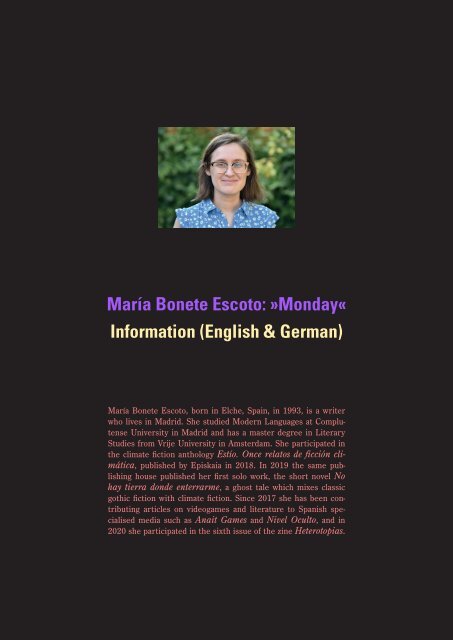





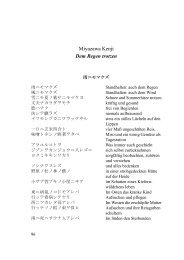
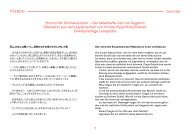
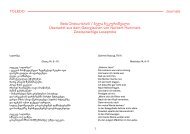
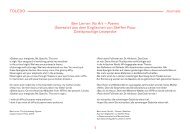

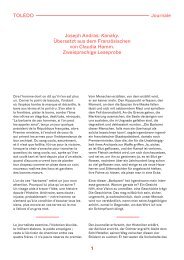
![[13] Perrone_Six Brazilian Songs_Bilíngue_DT](https://img.yumpu.com/65254747/1/184x260/13-perrone-six-brazilian-songs-bilingue-dt.jpg?quality=85)